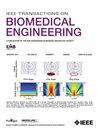结合屏气的慢对称呼吸对脑电图的调制。
IF 4.5
2区 医学
Q2 ENGINEERING, BIOMEDICAL
引用次数: 0
摘要
脑和肺之间的相互作用涉及双向运作的复杂生理机制。意志呼吸,不像自发呼吸,提供各种好处与潜在的治疗效果。意志呼吸涉及许多变量,如呼吸速率(BR)和呼吸模式。主要目的是研究慢对称呼吸(SSB)在不同频率下,在吸气和呼气后合并屏气和不合并屏气时的神经动力学。本文记录了63名健康成人在视觉节拍器引导下以每分钟10、6和4个周期呼吸时的脑电图(EEG)。在所有呼吸频率下,在SSB期间观察到相干性的显著增加和6 cpm (0.1Hz)的共振。此外,我们还研究了呼吸期的脑电信号波段功率变化、呼吸期与脑电信号振幅的耦合以及脑电信号调制。在屏气时α和β波段的功率明显高于吸气和呼气时。与基线相比,SSB期间调节指数显著增加,说明脑活动的调节增强。有趣的是,相干性、相幅耦合和调制指数主要依赖于呼吸频率,有屏气和没有屏气的对称呼吸之间的差异没有统计学意义。观察到的神经动力学在不同呼吸模式上的相似性表明,在保持报道的慢呼吸的好处的同时,用对称呼吸和屏气达到非常低的呼吸率是可行的。本文章由计算机程序翻译,如有差异,请以英文原文为准。
Modulation of EEG by Slow-Symmetric Breathing Incorporating Breath-Hold
The interplay between the brain and lungs involves intricate physiological mechanisms operating bidirectionally. Volitional breathing, unlike spontaneous breathing, offers various benefits with potential therapeutic effects. Volitional breathing involves many variables, such as breathing rate (BR) and breathing patterns. The main objective is to study the neural dynamics during slow-symmetric breathing (SSB) at different rates, with and without incorporating breath-holds post inhalation and exhalation. Electroencephalogram (EEG) is analyzed from 63 healthy adults while breathing at 10, 6, and 4 cycles per minute (cpm) guided by a visual metronome. A significant increase in coherence is observed during SSB at all breathing rates and resonance at 6 cpm (0.1 Hz). We also study EEG band power changes, coupling of the breathing phase with EEG amplitude, and EEG modulation during SSB. The power in alpha and beta bands is significantly higher during breath-hold than during inhalation and exhalation. Compared to the baseline, the modulation index increases significantly during SSB, illustrating the enhanced modulation of brain activity. Interestingly, coherence, phase-amplitude coupling, and modulation index depend mainly on the breathing rate, and the differences between symmetric breathing with and without breath-hold are not statistically significant. The observed similarities in neural dynamics across different breathing patterns suggest that achieving very low breathing rates is feasible with symmetric breathing with breath-holds while retaining the reported benefits of slow breathing.
求助全文
通过发布文献求助,成功后即可免费获取论文全文。
去求助
来源期刊

IEEE Transactions on Biomedical Engineering
工程技术-工程:生物医学
CiteScore
9.40
自引率
4.30%
发文量
880
审稿时长
2.5 months
期刊介绍:
IEEE Transactions on Biomedical Engineering contains basic and applied papers dealing with biomedical engineering. Papers range from engineering development in methods and techniques with biomedical applications to experimental and clinical investigations with engineering contributions.
 求助内容:
求助内容: 应助结果提醒方式:
应助结果提醒方式:


